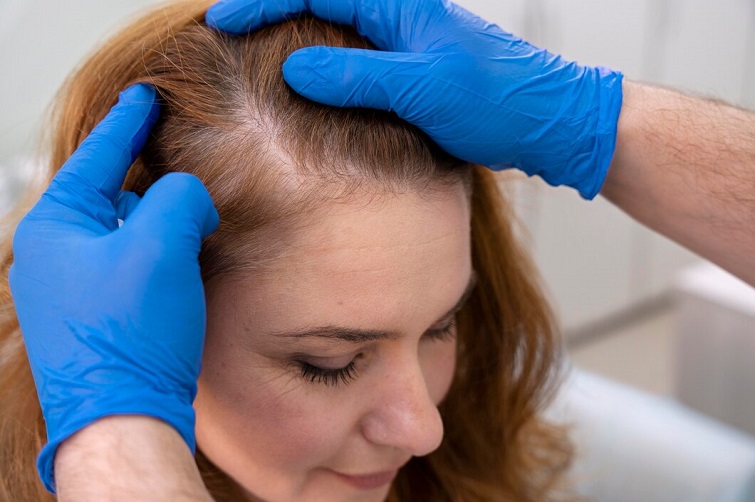Alopecia treatment
Alopecia treatment
Alopecia areata, commonly known as "coin-shaped hair loss," is a condition characterized by sudden hair loss in round, coin-sized patches. It can affect various parts of the body
Book Now
Alopecia treatment
Alopecia treatment
Alopecia Areata: Causes, Types, and Treatment
Alopecia areata, commonly known as "coin-shaped hair loss," is a condition characterized by sudden hair loss in round, coin-sized patches. It can affect various parts of the body, including the scalp, beard, eyebrows, eyelashes, neck, and other areas. This condition is of particular concern to many because it not only impacts appearance but also raises questions about its underlying causes. This article aims to explore the causes, types, symptoms, and available treatments for alopecia areata.
What is Alopecia Areata and What Causes It?
Alopecia areata is an autoimmune disorder in which the body's immune system mistakenly attacks hair follicles, mistaking them for harmful invaders like viruses or bacteria. This leads to inflammation and the disruption of hair growth. Several important points about alopecia areata include:
- Genetic Predisposition: Roughly one in five individuals with alopecia areata has a family history of the condition.
- Sudden Onset: Hair loss often happens abruptly, within just a few days.
- Misconceptions About Stress: While many believe stress plays a significant role, scientific evidence linking anxiety to alopecia areata is limited.
- Spontaneous Recovery: Individuals with mild cases, where only a few patches of hair loss appear, often recover fully without treatment.
- No Definitive Cure: While treatments exist, there is no permanent cure for alopecia areata.
Types of Alopecia Areata
Alopecia areata can manifest in different ways depending on the severity and location of the hair loss. The most common forms include:
- Alopecia Areata (Patchy): This is the most common and mild form, characterized by small, round patches of hair loss on the scalp. Sometimes, these patches can merge, forming larger areas of baldness.
- Alopecia Totalis: In this more advanced stage, nearly all hair on the scalp is lost, resulting in complete baldness. This form is more challenging to treat.
- Alopecia Universalis: This is the most severe type, where hair loss extends to the entire body, including eyebrows, eyelashes, and body hair.
- Beard Alopecia Areata: In men, this form affects the beard, leading to patchy hair loss on the face, which can affect overall appearance.
Each type of alopecia areata requires different treatment approaches, and early diagnosis can help manage symptoms and promote the regrowth of hair.
Symptoms of Alopecia Areata
The symptoms of alopecia areata are most noticeable through changes in the skin and nails. The condition typically begins with the formation of small, round, hairless patches on the scalp or body. These patches can be single or multiple and may expand over time. Other symptoms include:
- Scalp Pits: Dents or pitting on the scalp may appear in areas where hair loss is most severe.
- Nail Changes: Alopecia areata can also affect the nails, causing changes such as the appearance of white spots, roughness, brittleness, and loss of natural shine. These nail changes serve as indicators of the condition’s progression.
Early detection and intervention are crucial in managing the condition and preventing further hair loss or nail damage.
Diagnosis of Alopecia Areata
To diagnose alopecia areata, a dermatologist first examines the affected areas, looking for signs of hair loss and nail changes. The doctor will ask about the patient’s medical history and any patterns of hair loss in the family. In some cases, additional diagnostic tests, such as blood tests or a scalp biopsy, may be recommended to rule out other conditions and confirm the diagnosis.
Through this thorough diagnostic process, specialists can better understand the severity of the condition and suggest appropriate treatment options.
Treatment of Alopecia Areata
Though there is no permanent cure for alopecia areata, several treatments are available to help control the condition and encourage hair regrowth. Common treatments include:
- Corticosteroids: These anti-inflammatory drugs can be applied topically or injected directly into the scalp to suppress the immune system's attack on hair follicles.
- Topical Minoxidil: Often used for male-pattern baldness, minoxidil may also help stimulate hair growth in alopecia areata patients.
- Immunotherapy: This treatment involves applying chemicals to the skin that create an allergic reaction, stimulating hair regrowth in some cases.
- Natural Remedies: While many seek natural solutions, one popular home remedy is oil therapy, which involves applying essential oils such as rosemary or castor oil to the scalp to strengthen hair follicles and soothe inflammation.
Each of these treatments offers varying degrees of effectiveness, depending on the severity of the alopecia. In some mild cases, the hair may grow back on its own without treatment. However, for those with more widespread hair loss, medical treatments may be necessary to manage symptoms.
Conclusion
Alopecia areata is a complex autoimmune condition that can affect people of all ages and genders. While there is no definitive cure, advancements in treatments have made it possible to manage symptoms and stimulate hair regrowth in many cases. By understanding the causes, types, and available treatments for alopecia areata, individuals can take proactive steps toward managing their condition effectively.
Make an Appointment
The best way to enjoy a treatment at our salon is to book an appointment with the desired esthetician. Fill in the form below and we will contact you to discuss your appointment.